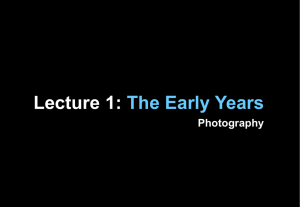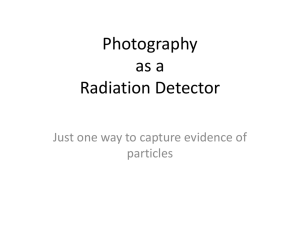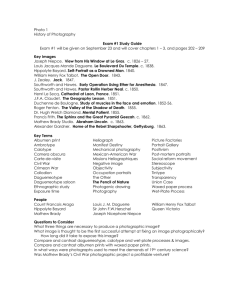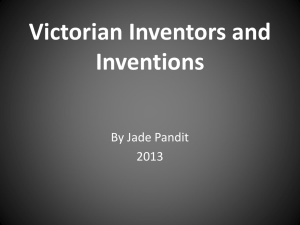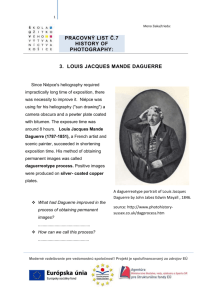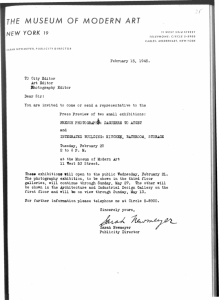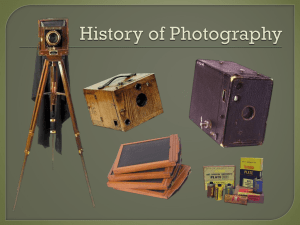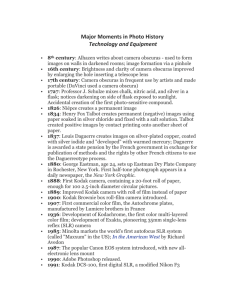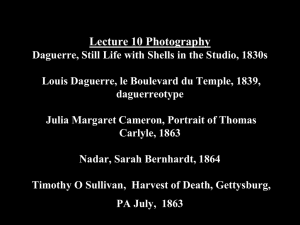Chapter 1: The Origins of Photography
advertisement
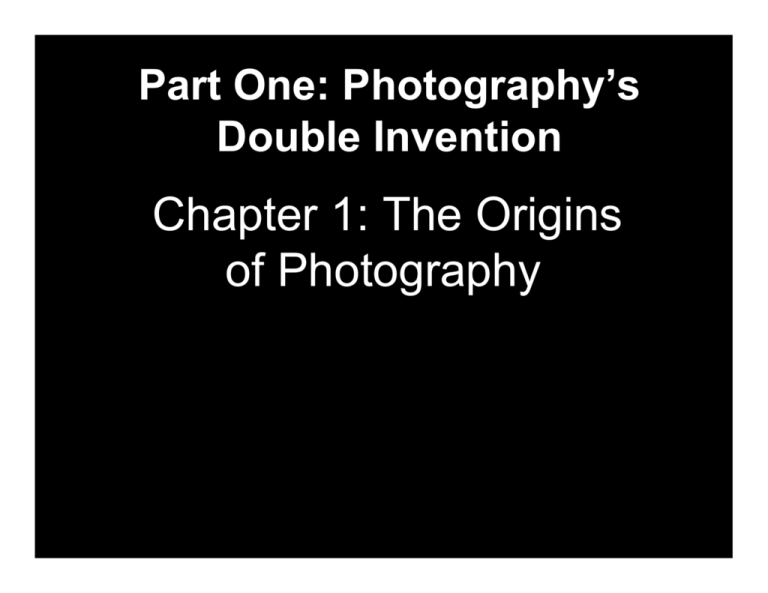
Part One: Photography’s Double Invention Chapter 1: The Origins of Photography Pre Photography: The Roots What was necessary for the invention of photography? " A light tight box (camera) Originally the camera obscura is used Lenses Available and manufactured by the Dutch for telescopes and microscopes since the 1600s Light-sensitive substances from the early 1600s, scientists knew that silver was sensitive to light • Camera Obscura The Camera Obscura • Literally “dark room” • Based on the principle that a small hole in a box produces an upside down image on the side of the box opposite the hole (pinhole camera) Manufactured by the Dutch starting in the 17th century With lenses and mirrors to turn the image right side up Used as a drawing aid for artists so they could get perspective correct Painting called “The Concert” by the Dutch artist Vermeer, in which Vermeer uses the camera obscura to create correct perspective. • Painting by Vermeer called View of Delft also using the camera obscura for perspective. Vermeer emphasizes the “circles of confusion” from the lens of the camera obscura. • Camera Lucida • Mechanical aid to help artists draw from nature more effectively Camera Lucida • The camera lucida, another devise that would help artists to draw from nature, is available from around 1807. • This is called the “light room” or camera lucida, instead of dark room or camera obscura • It consists of a prism with two silvered sided set on a rod • You were supposed to be able to see the scene you were looking at and the paper at the same time so you could trace the scene easily on the paper. Cape Town and Table Bay from just above Platte Klip Gorge, Table Mountain, Feb. 7. 1838, Sir John Herschel (1792-1871) camera lucida sketch • Johann Kaspar Lavater, Silhouette machine, c. 1780 • Silhouette or shadow drawing Silhouette or shadow drawing • The middle class tried to define itself as a distinct social class by buying these portraits. • People would sit in front of a sheet of paper with either candle light or sunlight casting a shadow of their profile onto the paper which the artist would then trace. • The artist might cut the profile out and use it as a guide to cut out their portrait from dark paper or just color in the outline with black ink. Silhouette or shadow drawing • This creates a very simple portrait- but one that emphasizes the actual shape of a person’s head, nose, personal features... • These portraits emphasize a sense of individualismindividual accomplishment among the bourgeoisie, or new middle class. • And obviously, a person could buy a silhouette portrait for much less than an oil painting. • So they appealed to the bourgeoisie in this way too. They could afford them. And they were made much more quickly than a painted portrait. • Silhouette vs. oil painting Compare these two types of portraits: Which one do you think cost more money? • Usually portraits of the aristocracy were very ornate, very fancy, and • the people were dressed up in very fancy clothes, with jewelry, • lots of fancy furniture and props. They were also very idealized- not natural at all • Portrait of Joseph Nicéphore Niépce by Leonard-Francois Berger, 1854 • Niépce, View from the Window at Gras, 1826, heliograph, 8 hour exposure Joseph Nicéphore Niépce • Well educated but his economic prospects were disturbed by the French Revolution • Invented an engine to run river boats • Was intrigued by lithography, but not good at drawing so tried to invent another way to make multiple copies of the same image • Invented a direct positive photographic process called heliography Joseph Nicéphore Niépce • In 1826 produced what we consider to be the first photograph- View from the Window at Gras • 8 hour exposure • See the sun move across the image • Tried to market this process unsuccessfully • Met Daguerre and they formed a partnership to collaborate on inventing a photographic process • Died unexpectedly in 1833 and Daguerre took his research and used it to invent his own process • Louis-Jacques-Mandé Daguerre • Daguerreotype portrait of Daguerre by Jean-Baptiste Sabatier-Blot, 1844 • Louis Jacques Mande Daguerre Landscape with Gothic Ruins Diorama 1821 • Daguerre Still Life (Interior of a cabinet of curiosities), 1837 • Daguerre View of the Boulevard du Temple, c. 1839, daguerreotype • Louis Daguerre, "The Louvre from the Left Bank of the Seine" • daguerreotype, 1839 Louis-Jacques-Mandé Daguerre • • • • • • • • Did not have much formal education Sagacious business man Outgoing personality, ambitious Owned a successful theater business called the Diorama- special effects/lights Works to invent a photographic process Figures out he has a latent image Partners with Niepce Invents his own process called the Daguerreotype (named after himself, of course!) Louis-Jacques-Mandé Daguerre • In 1838, Daguerre is getting ready to make his results public. • He lobbies prominent scientists to back him up so he will be taken seriously. • He meets up with the astronomer and politician Francois Arago. • At this point in time, the French government feels that it had a mission to support French intellectual life by funding science research and inventions. Louis-Jacques-Mandé Daguerre • So Arago goes to the French Academy of Science with Daguerre’s research. • Because the process for the daguerreotype is not scientifically complicated, and could be copied relatively easily, Arago suggests that the French government give Daguerre a pension for life- ie. a monthly stipend for the rest of his life, and then they would publish the daguerreotype process so anyone who wanted to could use it. • On January 7, 1839, Arago announces Daguerre’s process to the French Academy of Science and it is announced in the press. • Construction of a daguerreotype: hinged, velvetlined case, plate, frame, matte, and glass • the daguerreotype does not look or feel like a photograph. • its image rests on highly polished copper plate and its brilliant mirror like silver surface provides unparalleled visual depths this attribute also makes viewing problematic. • the daguerreotype's greatest technical advantage is its ability to render incredible detail. Daguerreotype • Direct positive on metal plate: only ONE copy is made. If you want additional copies you have to take them again. • Copper sheet plated with silver is highly polished, sensitized with iodine and placed into a camera obscura, exposed to light, exposed to mercury and washed with sodium chloride and then water • Early exposure times are 4 to 5 minutes Daguerreotype • • • • • • Pros: Very sharp, lots of detail, people loved this Metal plate is sturdy Highly mirrored surface, ghostly vision Cons: Does not have a full tonal range (no whites) since it is on a piece of metal • Does not have a negative, so you can’t make multiple prints • The surface is very shiny so it scratches easily, placed in cases to preserve them • Bayard, Self-Portrait as a Drowned Man, 1840, • direct paper positive “The body you see is that of Monsieur Bayard…The Academy, the King, and all who have seen his pictures admired them, just as you do. Admiration brought him prestige, but not a sou (dollar). The Government, which gave Mr. Daguerre so much, said it could do nothing for Mr. Bayard, and the wretch drowned himself.” • Hippolyte Bayard • Hippolyte Bayard • Creates the illusion that the statues are floating • Hippolyte Bayard: Self-Portrait with Plaster Casts, 1850 Hippolyte Bayard • Invents another direct positive process • His process is on paper and doesn’t have a name • Also meets Arago who convinces him to wait to announce his invention • Because he waits, he loses out credit to Daguerre • He gets angry and makes his image- Self Portrait of a Drowned Man • Calls into question whether photography “tells the truth” • Goes on to be part of the Historic Monument Commission William Henry Fox Talbot (1800-1877) William Henry Fox Talbot, Camera lucida drawing of the Terrace at the Villa Medici, October 5, 1833 “When first made the squares of glass, about 200 in number could be counted, with the help of a lens.” William Henry Fox Talbot, Latticed Window Taken with the Camera Obscura, Aug. 1835. Photogenic drawing negative, mounted on blackened paper • William Henry Fox Talbot • Leaf with Serrated Edge c. 1839 • Photogenic drawing negative • William Henry Fox Talbot, • botanical drawing, 1839, photogenic drawing • Photograms William Henry Fox Talbot, The Open Door, 1844, from The Pencil of Nature, salt print from a calotype negative. William Henry Fox Talbot, Articles of China, plate 3 from Pencil of Nature, 1844-46, calotype • William Henry Fox Talbot, Lacock Abbey Photogenic (light-caused) drawing process • Talbot used a photogram process for his photogenic drawings. • In other words, he placed an actual object, in this case a leaf, down on the light-sensitized paper and exposed it to the sun or to a light source. • This is a negative process and what this means is that where the light could reach the paper it turned the silver dark. • Photogram Photogenic (light-caused) drawing process • So he would place this leaf on the paper and where the sun could reach the paper- ie. where there was no leaf to cover the paper, the paper would turn dark. • Then he had to again fix the image so it didn’t continue to turn dark. • He discovered that a salt water solution would stop the development. • Images like this are called photograms and they are still made today. • Photogram Calotype Photograph (salt print) • Sensitized paper by soaking it in sodium chloride and then in silver nitrate • He put the paper in a camera and exposed it • He used sodium chloride again to stop the print from over exposing Calotype Photograph (salt print) • This first print is called a “negative” because the tones are reversed • He sandwiched the negative with another piece of sensitized paper to create a positive image • He could use the negative to create many identical positive image • Thus, the calotype process is the basis for modern photographic reproduction William Henry Fox Talbot, An Oak Tree in Winter, Negative and positive images Talbot’s photographic studio Calotype (salt print) • • • • • • Positive/Negative process Calotype negative is made of paper It produces a print that is soft Not a lot of detail Lots of dramatic shadows You can see the texture of the paper in the print, looks more painterly Calotype (salt print) • Pros: • You can make multiple prints from the negative • It has a full tonal range from white to black • Less expensive than a daguerreotype • Cons • Not as sharp as the daguerreotype • Paper, tears easily William Henry Fox Talbot • Talbot, who was British, knew Sir John Herschel. • He had had success as early as 1833 and 1834 in fixing a photographic image. • At the time he heard about Daguerre’s announcement he had been about to announce his discovery to the British Royal Society. • He didn’t know if his process was the same as Daguerre’s or different. • Talbot, unlike Daguerre who was not welleducated, had been educated at Cambridge and lived on his family estate (at Lacock Abbey). Sir John Herschel • • • • • • • • Early inventor of photography Was in contact with William Henry Fox Talbot Invented the cyanotype process This blue process is used to make both photograms and photographs What is the difference between a photogram and a photograph? The cyanotype process is still used today Herschel believed that photography should be a democratic process- available to everyone He helped young photographers- especially Anna Atkins and Julia Margaret Cameron Sir John Herschel, Woman with Harp
